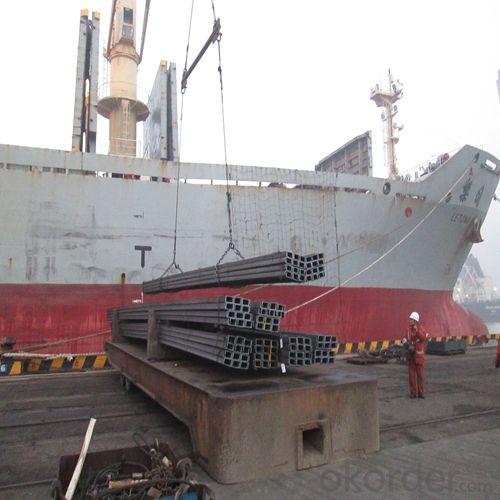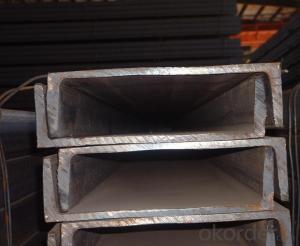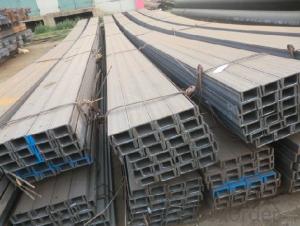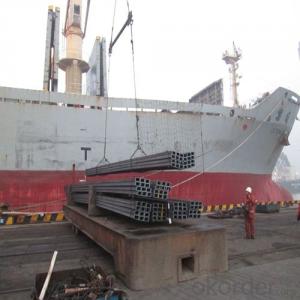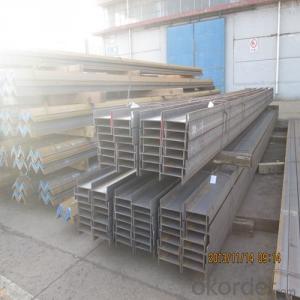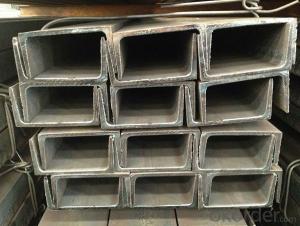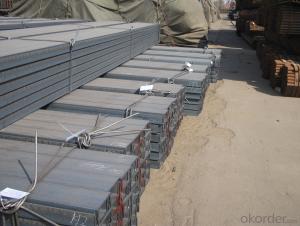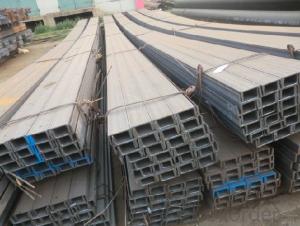Hot Rolled Structure Steel U-Channel JIS Standard GB Standard
- Loading Port:
- Tianjin
- Payment Terms:
- TT OR LC
- Min Order Qty:
- 100 m.t.
- Supply Capability:
- 30000 m.t./month
OKorder Service Pledge
OKorder Financial Service
You Might Also Like
Product Description:
Steel U Channel Details:
Minimum Order Quantity: 25 Tons Unit: m.t. Loading Port: Xingang Port
Supply Ability: 1000 Tons Per Day Payment Terms: TT or L/C
Product Description:
Specifications of Steel U Channel:
Standard Applied: GB Standard, EN Standard(UPN), JIS Standard
Sizes: 50mm to 300mm
Material Grade: Q235B, Q345B, S235JR, SS400, ASTM A36
As shown in the figure:
| JIS U CHANNEL | Standard h | Sectional b | Dimension s | t | Mass: Kg/m |
| (mm) | (mm) | (mm) | (mm) | ||
| 50x25 | 50 | 25 | 3.0 | 6.00 | 2.37 |
| 75X40 | 75 | 40 | 3.8 | 7.00 | 5.30 |
| 75X40 | 75 | 40 | 4.0 | 7.00 | 5.60 |
| 75X40 | 75 | 40 | 4.5 | 7.00 | 5.85 |
| 75X40 | 75 | 40 | 5.0 | 7.00 | 6.92 |
| 100X50 | 100 | 50 | 3.8 | 6.00 | 7.30 |
| 100X50 | 100 | 50 | 4.2 | 6.00 | 8.03 |
| 100X50 | 100 | 50 | 4.5 | 7.50 | 8.97 |
| 100X50 | 100 | 50 | 5.0 | 7.50 | 9.36 |
| 125X65 | 125 | 65 | 5.2 | 6.80 | 11.66 |
| 125X65 | 125 | 65 | 5.3 | 6.80 | 12.17 |
| 125X65 | 125 | 65 | 5.5 | 8.00 | 12.91 |
| 125X65 | 125 | 65 | 6.0 | 8.00 | 13.40 |
| 150x75 | 150 | 75 | 5.5 | 7.30 | 14.66 |
| 150x75 | 150 | 75 | 5.7 | 10.00 | 16.71 |
| 150x75 | 150 | 75 | 6.0 | 10.00 | 17.90 |
| 150x75 | 150 | 75 | 6.5 | 10.00 | 18.60 |
3. The chemical composition of HR Channel Steel according to Q235B is shown in Table-2.
Alloy No | Grade | Element(%) | ||||
C | Mn | S | P | Si | ||
Q235 | B | 0.12-0.20 | 0.3-0.7 | ≦0.045 | ≦0.045 | ≦0.3 |
Table-2
Note: we are able to present our customers relevant SGS test report for chemical composition of HR Channel Steel.
4. The mechanical property of HR Channel Steel according to Q235B is shown in Table-3-1 and Table-3-2
Alloy No | Grade | Yielding Strength Point(Mpa) | |||
Thickness(mm) | |||||
≦16 | >16-40 | >40-60 | >60-100 | ||
≧ | |||||
Q235 | B | 235 | 225 | 215 | 205 |
Table-3-1
Alloy No | Grade | Tensile Strength(Mpa) | Elongation After Fracture(%) | |||
Thickness(mm) | ||||||
≦16 | >16-40 | >40-60 | >60-100 | |||
≧ | ||||||
G235 | B | 375-500 | 26 | 25 | 24 | 23 |
Usage/Applications of Channel Steel:
Channel Steel is usually used for building structure, vehicle manufacturing and other industrial structure and often used with i beam.
In details, the channel steel belongs to carbon structural steel which is applied to in the field of construction and machinery. The channel steel is usually used for arch-itechtural structure, and they could be welded in order to support or hang a vari-ety of facilities. They are also usually used in combination with I beam. Generally,the channel steel must possess perfect welding property, riveting property and mechanical property and so on.
Package & Delivery of Channel Steel:
The steel u channel will be packed in bundle with steel wire at each end of every bundle and color marking in order to help the customer to recognize his goods more easily at sight.
And steel u channel could be loaded into 20ft or 40ft container, or by bulk cargo. If the weight of each bundle reaches less than 3.5 mt, the loading by break bulk cargo should be choosed. When the weight of each bundle reaches less than 3mt, the loading by container should be choosed.
As for the transportaion from mill to loading port, the truck will be usually used. And the maximum quantity for each truck is 40mt.
- Q: How do steel channels contribute to the overall safety of a structure during floods?
- Steel channels contribute to the overall safety of a structure during floods in several ways. First and foremost, steel channels provide structural support and reinforcement to the building, making it more resistant to the forces and pressure exerted by floodwaters. These channels are designed to withstand high loads and distribute the weight evenly, ensuring the stability and integrity of the structure even in extreme flood conditions. Additionally, steel channels can be strategically placed in flood-prone areas to redirect the flow of water away from critical areas of the building. By creating barriers or channels, they help to control and manage the water flow, preventing it from entering vulnerable spaces or causing damage to the foundation. This redirection of water minimizes the risk of structural failure or collapse during floods. Moreover, steel channels are highly resistant to corrosion, which is crucial in flood-prone areas where water exposure is frequent. By using corrosion-resistant steel channels, the risk of deterioration and weakening of the structure due to prolonged exposure to water is significantly reduced. Furthermore, steel channels can be utilized to create flood-resistant doors and barriers. These doors are designed to withstand the water pressure and prevent its entry into the building. This is particularly important in critical areas such as basements or lower levels, where water infiltration can cause extensive damage to utilities or compromise the overall stability of the structure. In summary, steel channels contribute to the overall safety of a structure during floods by providing structural support, redirecting water flow, resisting corrosion, and creating flood-resistant barriers. By incorporating these features into the design and construction of a building, the risk of damage and destruction during floods can be significantly mitigated, ensuring the safety of occupants and preserving the integrity of the structure.
- Q: What are the different methods of cutting steel channels?
- There are several different methods of cutting steel channels, depending on the specific requirements and tools available. Some common methods include: 1. Manual Cutting: This involves using hand tools such as hacksaws, bolt cutters, or shears to cut through the steel channels. This method is suitable for smaller projects or when only a few cuts are needed. 2. Plasma Cutting: Plasma cutting uses a high-velocity jet of ionized gas (plasma) to cut through steel channels. This method is fast, precise, and can be used for both straight and curved cuts. Plasma cutting is typically done with a CNC plasma cutting machine for larger projects. 3. Laser Cutting: Laser cutting uses a high-powered laser beam to melt or vaporize the steel channels, creating a precise cut. This method is efficient, produces clean edges, and is suitable for both thick and thin steel channels. Laser cutting is commonly used in industrial applications. 4. Waterjet Cutting: Waterjet cutting utilizes a high-pressure stream of water mixed with abrasive particles to cut through steel channels. This method is versatile, as it can cut through various thicknesses and materials, including steel. Waterjet cutting is known for its accuracy and ability to create complex shapes. 5. Saw Cutting: Saw cutting is a traditional method that involves using a circular saw or band saw with a blade specifically designed for cutting metal. This method is suitable for straight cuts and can be used for both thin and thick steel channels. 6. Oxy-Fuel Cutting: Oxy-fuel cutting involves using a mixture of fuel gas and oxygen to heat the steel channels to their ignition point, then introducing a high-pressure stream of oxygen to create a cut. This method is primarily used for cutting thicker steel channels and is commonly used in heavy industrial applications. It's important to consider factors such as the required precision, speed, and budget when choosing a cutting method for steel channels.
- Q: Can steel channels be used in outdoor environments?
- Yes, steel channels can be used in outdoor environments. Steel is a durable and strong material that is capable of withstanding various weather conditions and environmental factors. It has excellent resistance to rust and corrosion when properly coated or galvanized, making it suitable for outdoor applications. Steel channels can be used in outdoor construction projects such as bridges, fences, railings, and support structures. However, it is important to ensure that the steel channels are properly protected and maintained to prevent any potential damage or degradation over time.
- Q: What kind of welding rod used for channel steel?
- 20 steel can use knot 422, knot 423, knot 424, knot 425; strength high occasion, knot 506, knot 507. 304 steel with Austria 102, Austria 107, Austria 002 welding rod.
- Q: What are the different methods of finishing steel channels?
- There are several methods of finishing steel channels, each with its own unique characteristics and benefits. Some of the most common methods include: 1. Hot-dip galvanizing: This process involves immersing the steel channels in a bath of molten zinc. The zinc coating provides excellent corrosion resistance, making it ideal for outdoor applications. Hot-dip galvanizing also creates a durable and long-lasting finish. 2. Powder coating: Powder coating involves applying a dry powder to the steel channels and then curing it under heat. This method provides a thick and even coating that is highly resistant to chipping, scratching, and fading. Powder coating is available in a wide range of colors and finishes, allowing for customization. 3. Paint coating: Steel channels can also be finished with various types of paint coatings. These coatings provide both aesthetic appeal and protection against corrosion. Paint coatings can be applied using spray guns, brushes, or rollers, and they offer flexibility in terms of color and texture. 4. Electroplating: Electroplating is a process in which a thin layer of metal, such as chrome or nickel, is bonded to the steel channels through an electrochemical reaction. This method enhances the appearance of the steel channels, providing a decorative and lustrous finish. Electroplating can also improve the corrosion resistance of the steel. 5. Anodizing: Anodizing is primarily used for finishing aluminum channels but can also be used on steel channels. It involves creating an oxide layer on the surface of the metal through an electrochemical process. Anodized steel channels have increased corrosion resistance, improved hardness, and can be dyed in various colors. 6. Mechanical finishes: Mechanical finishes are achieved through processes such as grinding, polishing, or brushing. These finishes alter the surface texture of the steel channels, creating a specific appearance or removing imperfections. Mechanical finishes can range from a smooth and glossy look to a matte or textured finish. Overall, the choice of finishing method for steel channels depends on the desired appearance, level of corrosion resistance, and the specific application requirements. Each method offers its own advantages and considerations, enabling manufacturers and end-users to select the most suitable finish for their needs.
- Q: What are the different cross-sectional shapes available for steel channels?
- Steel channels, which are also known as C-channels or U-channels, find extensive use in the construction, manufacturing, and other industries due to their versatility and strength. These channels exhibit a variety of cross-sectional shapes, each offering distinct advantages and applications. The C-shape represents the most commonly encountered cross-sectional shape for steel channels. C-channels possess a straight back and two perpendicular flanges, which combine to create a profile resembling the letter C. This shape delivers exceptional structural support and often finds employment in building frames, support beams, and structural components. An alternative, widely favored cross-sectional shape is the U-shape. U-channels bear a resemblance to C-channels, but they feature a rounded bottom rather than a straight back. This rounded shape enhances strength and frequently serves applications requiring greater load-bearing capacity like bridge supports and trailer frames. Besides the C and U shapes, steel channels can also manifest in other cross-sectional profiles, including Z-shapes and hat channels. Z-shaped channels possess two flanges facing opposite directions, giving them a visual resemblance to the letter Z when viewed from the end. These channels frequently see use in bracing or framing applications necessitating added stiffness. On the other hand, hat channels consist of a flat horizontal top and bottom with two perpendicular sides, resembling the shape of a hat. Hat channels commonly act as purlins, allowing for the attachment of roofing or cladding sheets to steel structures. In conclusion, the availability of various cross-sectional shapes for steel channels permits a wide array of applications and offers diverse benefits in terms of strength, load-bearing capacity, and stiffness. The selection of an appropriate cross-sectional shape hinges upon the specific requirements and intended utilization of the steel channel in question.
- Q: Can steel channels be used in the agricultural parts manufacturing industry?
- Indeed, the agricultural parts manufacturing industry can utilize steel channels. Due to their versatility and strength, steel channels prove to be fitting for a multitude of applications within the agricultural sector. They can effectively produce structural components like support beams, frames, or braces for agricultural machinery such as tractors, harvesters, or irrigation systems. The exceptional strength and durability of steel channels enable them to endure heavy loads and harsh environmental conditions commonly encountered in agricultural settings. Furthermore, steel channels can be conveniently fabricated, welded, and tailored to meet precise specifications, rendering them an advantageous option for manufacturing agricultural parts.
- Q: Can steel channels be used in automotive applications?
- Yes, steel channels can be used in automotive applications. Steel channels are commonly used in the automotive industry for various purposes, such as reinforcing structural components, providing support, and enhancing the overall strength and durability of vehicles. They are often used in the construction of chassis frames, body panels, and other structural components of automobiles. Steel channels offer excellent strength-to-weight ratio, which is crucial for automotive applications as it helps in reducing the overall weight of the vehicle while maintaining structural integrity. Additionally, steel channels can be easily shaped, welded, and formed into desired configurations, making them versatile and suitable for various automotive requirements.
- Q: How do steel channels contribute to the overall durability of a building?
- Steel channels contribute to the overall durability of a building in several ways. Firstly, they provide structural support by distributing the load evenly across different parts of the building, ensuring stability and preventing deformation. Additionally, steel channels have high tensile strength, allowing them to withstand heavy loads and forces, such as those caused by wind or earthquakes. They also enhance the building's resistance to corrosion and fire due to their non-combustible nature and protective coatings. Overall, steel channels significantly enhance the longevity and safety of a building, making it more durable and robust.
- Q: Can steel channels be used for electrical wiring?
- No, steel channels cannot be used for electrical wiring. Steel channels are typically used for structural support in construction and are not designed to contain electrical wires. Electrical wiring requires specific types of conduits or cable trays that are made of materials like PVC or metal, which are specifically designed to safely contain and protect electrical wires. These conduits or cable trays provide insulation and prevent any potential electrical hazards, such as short circuits or electrical shocks. Therefore, it is important to use the appropriate materials and methods specifically designed for electrical wiring to ensure safety and compliance with electrical codes and regulations.
Send your message to us
Hot Rolled Structure Steel U-Channel JIS Standard GB Standard
- Loading Port:
- Tianjin
- Payment Terms:
- TT OR LC
- Min Order Qty:
- 100 m.t.
- Supply Capability:
- 30000 m.t./month
OKorder Service Pledge
OKorder Financial Service
Similar products
Hot products
Hot Searches
Related keywords





